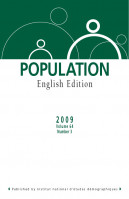
Population 2009, n° 3
2009
- DEMOGRAPHIC DEVELOPMENTS IN FRANCE
- Recent Demographic Developments in France: Tenth Anniversary of the PACS Civil Partnership, and Over a Million Contracting Parties - F. Prioux, M. Mazuy
- Abortion Trends in France, 1990-2005 - C. Rossier, L. Toulemon, F. Prioux
ARTICLES
- Pro-Natalism and Hygienism in France, 1900-1940. The Example of the Fight against Veneral Disease - V. De Luca Barrusse
- Trajectories of Immigrants’ Children in Secondary Education in France: Differentiation and Polarization - Y. Brinbaum, A. Kieffer
- Losses and Changes of Filiation among Children Born in France since the 1960s - F. Munoz-Pérez
- BOOK REVIEWS
Recent Demographic Developments in France: Tenth Anniversary of the PACS Civil Partnership, and Over a Million Contracting Parties
France Prioux, Magali Mazuy
The population of metropolitan France (mainland and Corsica) on 1 January 2009 was estimated at 63.2 million. Natural growth was again strongly positive in 2008, and almost identical to that of 2007, with the increase in births partly offset by a rise in deaths. The number of foreigners admitted for residence fell slightly more sharply in 2007 than in the two previous years. The estimated total fertility rate was 2 children per woman in 2008, a level close to the completed fertility of the 1970 cohort. The number of abortions remained stable, but their frequency increased slightly among the youngest women. The number of PACS civil partnerships signed in 2008 increased yet again, both for same-sex couples and for heterosexual couples. Marriages fell slightly, and the probability of marrying for single people has never been lower. Most of the divorces pronounced in 2008 were by mutual consent. Male life expectancy at birth increased slightly (+0.14 years) and that of women remained stable (-0.06 years).
Abortion Trends in France, 1990-2005
Clémentine Rossier, Laurent Toulemon, France Prioux
Abortion was legalized in France in 1975. Several amendments to the Abortion Act were passed in 2001 aimed at facilitating women’s access to pregnancy termination. In particular, the maximum gestational age at which elective termination may be performed (the legal limit) was extended by two weeks. Data from induced abortion notifications can be used to study the impact of these amendments, by using the gestational age at termination as an indicator of difficulty in accessing termination services. Following the legalization of medical methods of contraception in France in 1967, the decline in unplanned pregnancies and elective terminations up to the mid-1990s can be attributed to the effective diffusion of medical methods of contraception in the 1970s and 1980s. Abortion rates nevertheless remain high in France compared with other western European countries. This raises two issues that warrant investigation: the persistence or increase in unplanned pregnancies among the youngest women, and repeat abortions by some women in their lifetimes.
Pro-Natalism and Hygienism in France, 1900-1940. The Example of the Fight against Veneral Disease
Virginie De Luca Barrusse
How are the criteria of quantity and quality combined in population policies? The fight against "social scourges" in France between 1900 and 1940 is a very interesting case in point, revealing the complexity of the arguments deployed in population policies. Among these scourges, the fight against venereal disease represents an extreme case linked to the representations of sexually transmitted infections. Shameful and therefore unmentionable, these diseases were rarely exposed to public attention, despite concern about depopulation. The questions of population quality and quantity became crystallized around the productivity of marriage. A network of physicians thus took it upon themselves to educate the population about venereal diseases and their adverse effects on the population and the family. The content of this propaganda, notably the anti-venereal films, leaves not doubt as to the role of pro-natalism in health education.
Trajectories of Immigrants’ Children in Secondary Education in France: Differentiation and Polarization
Yaël Brinbaum, Annick Kieffer
Inequalities in education according to immigrant and social origin are analysed by examining performance at the start and end of lower secondary school (collège), the track choices made at upper secondary school (lycée), and qualifications obtained among a panel of students who entered year 6 in 1995 in France. The inequalities affecting immigrants’ children are forged in primary school, but get no worse afterwards. Examining both absolute and relative data, the educational difficulties of these young people are confirmed, more so for boys than for girls. However, the difference between these students and their French-origin counterparts from the same socio-occupational background is quite small. Leaving school unqualified is the result of failing examinations in the case of students of North African origin, while those of Portuguese origin leave school to enter the labour market. Although over half of the student cohort obtains the baccalauréat, this is often a low-status technology or vocational baccalauréat. The gender gap in achievement is higher among students of immigrant background. We thus observe a differentiation in educational trajectory by origin and a gender polarization
Losses and Changes of Filiation among Children Born in France since the 1960s
Francisco Munoz-Pérez
A survey conducted by INED in 1997 using civil records as well as recent legal statistics retraced the way losses of paternal and of double filiation have evolved since the 1960s in France. The major shifts in conjugal behaviour during this period were not accompanied by further instability in filiation, and children are less likely to suffer now from loss of filiation than they were thirty or forty years ago. Children born outside marriage, those most affected by losses of filiation in the past, benefit the most from this greater stability. So do children born within marriage, for whom loss of filiation is very rare nowadays. Many children who have lost their paternal filiation benefit from a second filiation, particularly when the child is born in marriage. The vast majority of those who lose their double filiation obtain a new one, whether or not they were born in marriage
Prix TTC : 20,00 €

